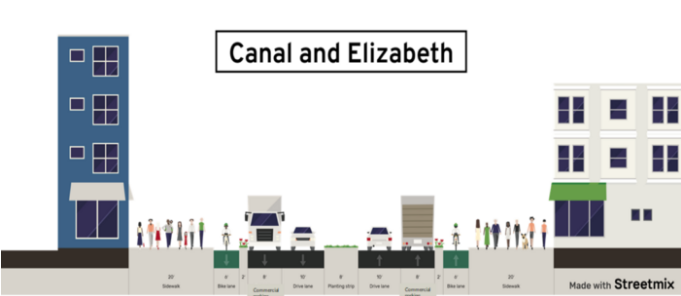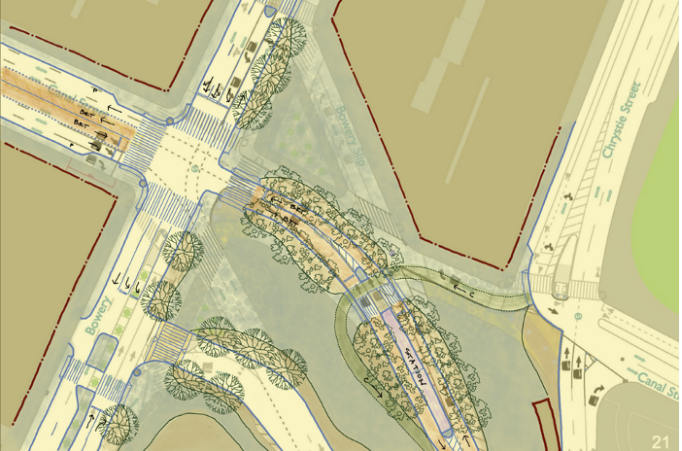This article first appeared in the Reorientations blog and is reprinted with permission.
Canal Street in Manhattan shares the incompatible functions of being the main commercial street through Chinatown and the most direct link for cars and trucks traveling from Brooklyn to New Jersey. Not only does its through nature cause Canal Street to be incredibly unpleasant for those attempting to walk, shop, or eat there, it also creates a highly unsafe environment.
Per a January 2020 Streetsblog article: “there have been 2,567 reported crashes on just the stretch of Canal Street between the Manhattan Bridge and Hudson Street since 2016 — close to two crashes per day. The crashes injured 54 cyclists (killing one), 109 pedestrians and 229 motorists (also killing one).”
Any minor relief the street might have gotten during the pandemic has now vanished.
Today, Canal Street is about 100-feet wide in most sections. About 82 of these feet are devoted to vehicles.

A few months ago, Michael King and I worked with the Transportation Alternatives's Manhattan Activist Committee to figure out what should be done to #fixcanal. Below are some proposals which more or less work from river to river. More site-specific improvements are possible but are not covered here.
Ban Left Turns
Back in 2011, the New York Metropolitan Transportation Council issued a major study, the Canal Area Transportation Study, known as CATS II. One key recommendation of CATS II was to prohibit all left turns off of Canal Street. Left turns are one of the most dangerous traffic movements. In fact, on its website, the Department of Transportation accurately identifies some dangers of left turns, including:
- Left turns can be taken at a wider radius, which leads to higher speeds and greater pedestrian exposure
- Left turns are more complicated than right turns, and require more mental and physical effort.
CATS II went as far as to identify alternative routings, usually involving three right turns, for drivers who want to turn left from Canal Street. A 2017 Hudson Square Study also recommended restricting left turns.

None of the left turns was ever banned.
In addition to creating a safer Canal Street, banning left turns would allow the city to grab back some road real estate used for left turn bays. This new space could be used for widening the overcrowded sidewalk, providing a pedestrian refuge island, or even adding a bike lane.
Fix parking
Canal Street has a double-parking problem. On some blocks, trucks that are loading or unloading must double park as there is already a vehicle parked at the curb. Double parking effectively reduces the number of lanes on a street, forcing vehicles to weave, which creates traffic congestion, a polluting and unpleasant problem for pedestrians walking along Canal Street.

In fact, the city has done well to make it illegal for general traffic to park on Canal from 7 a.m. to 7 p.m. Three-hour metered commercial vehicle parking during some of the most congested hours is a good idea that theoretically should help reduce double parking of commercial vehicles. But because double parking persists during these hours, an even more stringent policy is needed. Many commercial vehicles spend only a few minutes loading and unloading, but others stage themselves in such commercial parking zones for wider distribution around an area.
The pricing for commercial vehicles along Canal Street is: $5 for the first hour, $6 for the second hour, and $7 for the third hour. This progressive pricing structure can be effective at reducing the time spent at the curb; however, such low prices do little to deter multi-hour parking. The city should raise the prices significantly and create a steeper step-up from one hour to the next.
The fine for parking beyond three hours is $65. Some commercial operators are simply willing to absorb this cost to avoid the time spent moving their vehicle. This fine should also be raised to an amount that works as a reasonable deterrent.
Further, there is extreme placard abuse on Canal Street, even during commercial-vehicle-parking hours. Placard abuse has been the subject of many articles so I won’t discuss it here but needless to say, it should be dealt with.
Finally, beginning at 7 p.m., and all day on Sundays, Canal Street opens its curbs to all traffic. There is little reason to provide so much on-street parking for visitors to Canal Street and Chinatown at any hour. Canal Street is served by ten subway lines, which operate 24/7. The CATS II study also found that “of the three surveyed time periods [weekday AM, weekday PM, Sunday midday], Sunday had the highest percentage of local traffic.” The study goes on to explain that on Sundays, more drivers are looking for parking, resulting in increased Sunday congestion on Canal Street. The city should prohibit general vehicle parking at nights and on Sundays along Canal Street, perhaps allowing loading only during these hours.
If the measures proposed above are taken, double-parking instances should drop, allowing traffic to move more freely in the lane adjacent to the parking lane.
Of course, even better than helping traffic to move better would be to acknowledge that Canal Street is effectively narrowed due to the blocks with frequent double parking, and simply turn today’s double-parking lane into tomorrow’s curb. This opens up the possibility for widening the sidewalk, adding a wide planted median, or adding parking-protected bike lanes. With the space from some left turns reclaimed, more than one of these people-friendly solutions can be chosen.

Gateways to Chinatown Parklet
There exists a dismal triangle at the crossroads of Canal, Baxter, and Walker. In the middle sits the so-called Gateways to Chinatown. The Gateways are not particularly pleasant, because it's on an island in the middle of three traffic-filled streets.

In 2019, the DOT hired Lindy Lee to redesign the Gateway monument. The Dragon’s Roar, while interesting and hotly debated in the Chinatown community, misses the point that the real reason the Gateway is unappealing is that it’s on an island surrounded by traffic.

The city should close the adjacent block of Walker to vehicular traffic and create the Gateways to Chinatown Parklet. There is precedent nearby at Division and Canal. Closing Walker would actually connect The Gateways to Chinatown … to Chinatown.

Congestion pricing could be a game-changer for Canal Street
If congestion pricing ever happens, Canal Street might truly become transformed. Today, the fastest way to get from South Brooklyn or Staten Island to Jersey City is via the Brooklyn Battery Tunnel. Yet because of the toll on the Battery Tunnel, most New Jersey-bound drivers — many of them trucks — opt to take the Manhattan Bridge and cross Canal Street to get to the Holland Tunnel.
The city should plan proactively, rather than reactively, for congestion pricing, as the start of congestion pricing is their one chance to get it right. A successful congestion pricing plan should have improved transit as an alternative to driving. As we discussed in a previous post, there is very little interborough bus service and no service across the Manhattan Bridge. The MTA should consider extending the B41 across the Manhattan Bridge and across Canal Street. The DOT could use some of the space it saves through the measures described above for the bus.

Finally, the Manhattan Bridge is terribly imbalanced. There are five Manhattan-bound lanes and only two in the Brooklyn-bound direction. The city should convert the three excess Manhattan-bound lanes on the lower level to other uses, including bus and bike. Frankly, it could do this with or without congestion pricing, but congestion pricing would give it the opening. It should take it.

Removing three inbound lanes on the Manhattan Bridge would allow the base of the bridge on the Manhattan side to be restored to the plaza it once was — rather than the dangerous car sewer it is today.
Canal Street doesn’t have to be a through street for trucks. It doesn’t have to kill people every year. It doesn’t even have to be so unpleasant. The fixes are obvious. Rather than doing a million more studies, the city should just fix it.
Annie Weinstock (@Annie_Weinstock) is the director of programs of People Oriented Cities and, with Walter Hook, helms its Reorientations blog.








